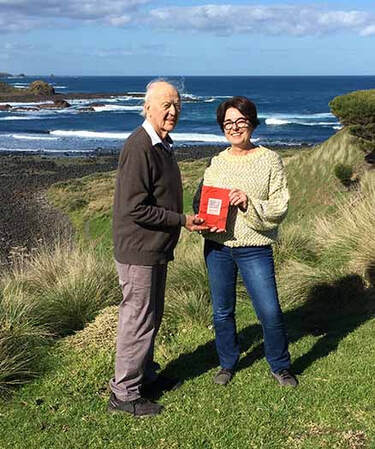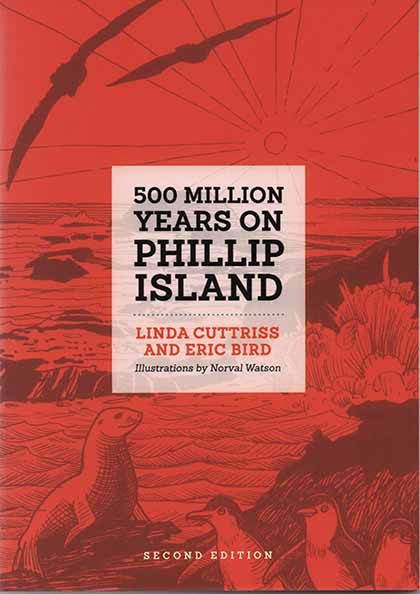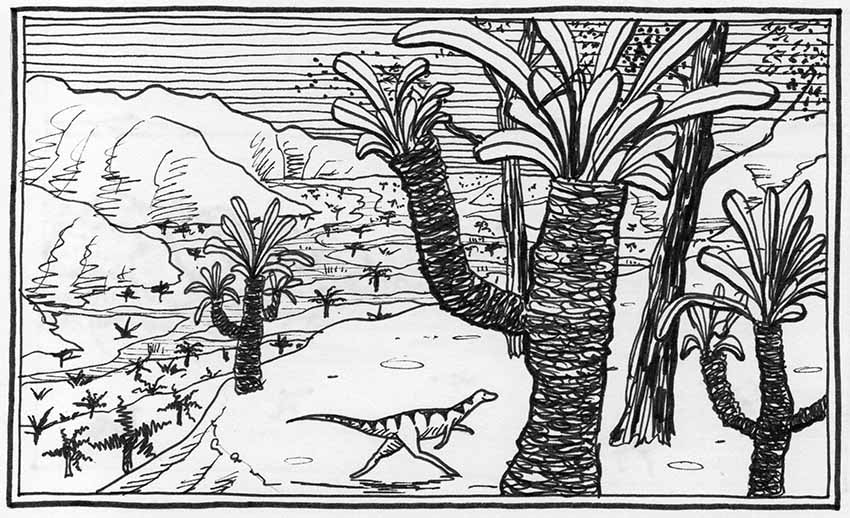 Twenty-five years after the first edition of their geological history of Phillip Island, Linda Cuttriss and Eric Bird see a growing awareness
Twenty-five years after the first edition of their geological history of Phillip Island, Linda Cuttriss and Eric Bird see a growing awareness of how precious the island is.
By Anne Davie
IT IS extraordinary that such an array of stunning coastal features, scenic landscapes and so many interesting wildlife species occurs in an island that stretches little more than 20 kilometres end to end. Phillip Island is a unique and a special place.
The second edition of 500 Million Years on Phillip Island, by Linda Cuttriss and Eric Bird, is the story of our island and how it came to be.
Linda is well known in Bass Coast as a winner of the 2020 Bass Coast Prize for Non-Fiction. She grew up on a dairy farm in Inverloch and now lives on Phillip Island. Her professional life includes education, environment and community engagement and she is an active Island environmentalist.
IT IS extraordinary that such an array of stunning coastal features, scenic landscapes and so many interesting wildlife species occurs in an island that stretches little more than 20 kilometres end to end. Phillip Island is a unique and a special place.
The second edition of 500 Million Years on Phillip Island, by Linda Cuttriss and Eric Bird, is the story of our island and how it came to be.
Linda is well known in Bass Coast as a winner of the 2020 Bass Coast Prize for Non-Fiction. She grew up on a dairy farm in Inverloch and now lives on Phillip Island. Her professional life includes education, environment and community engagement and she is an active Island environmentalist.
Eric Bird came to Australia in 1955, completing a PhD at Australian National University, and went on to become associate professor in the Department of Geography at Melbourne University. He has specialised in coastal geomorphology in Australia and overseas and has published 10 books. Eric has been a frequent visitor to Phillip Island and has prepared reports on beach erosion for the Phillip Island Conservation Society.
In the new edition, the authors explore the changes that have occurred on the Island since the first edition was published in 1995. The book has glimpses of the First People’s lives and their soft footprint on the Island. They describe the impact of the first European explorers and settlers, and how the generations of farmers, townsfolk and tourists who followed have radically changed the physical and human landscape.
In the new edition, the authors explore the changes that have occurred on the Island since the first edition was published in 1995. The book has glimpses of the First People’s lives and their soft footprint on the Island. They describe the impact of the first European explorers and settlers, and how the generations of farmers, townsfolk and tourists who followed have radically changed the physical and human landscape.
| A geological time chart of the past 560 million years is very informative. It is remarkable that volcanic greenstones identified on the shore near Watts Point in the Island are Pre-Cambrian – dated 560 million years BP (before present). There are many examples still evident on the Island of its ancient geomorphology. Residents and visitors will marvel at the revelation of the island’s age. Hundreds of millions of years ago the rocks that were to become the basement of Phillip Island lay deep beneath the sea. Our family is privileged to care for Bunurong country on Richardson’s Hill, Ventnor. Fifty million years ago in the Eocene, molten rock was forced up and remains as a volcanic vent. I see it every day from our window and I am in awe. 500 Million Years on Phillip Island not only provides the geomorphological history of the Island, it tells how human occupation continues to change land use and landscape. Farmers are being challenged by the effects of climate change. Housing development is ongoing. Tourists visit annually in increasing numbers. |
Cultural geographers provide an important way of looking at relationships between people and the surrounding landscapes. They explain cultural landscape as an expression of how people engage with their world.
The more superficial a society’s knowledge of the real dimensions of its history and the land it occupies, the more vulnerable the land is to exploitation, to manipulation and short-term goals. The land becomes just a commodity.
The authors give us hope as they believe that, since the publication of the first edition, there are many positive outcomes of people coming together on Phillip Island to address the restoration and renewal of the natural environment. They realise that people power and action can ensure preservation of the Island’s precious assets.
500 Million Years on Phillip Island is a great gift to Phillip Island from Linda and Eric, its dedicated and informed authors. I commend it to all who believe that the natural and human history of a place must be respected, valued and sustained.
Anne Davie will launch 500 Million Years on Phillip Island at St John’s Uniting Church in Cowes on Sunday, August 22, at 2.30pm. The event is presented by the Island Story Gatherers and includes a Q&A with the authors by Dr Laura Brearley and music by Rosie Westbrook. Tickets through Trybooking.
The more superficial a society’s knowledge of the real dimensions of its history and the land it occupies, the more vulnerable the land is to exploitation, to manipulation and short-term goals. The land becomes just a commodity.
The authors give us hope as they believe that, since the publication of the first edition, there are many positive outcomes of people coming together on Phillip Island to address the restoration and renewal of the natural environment. They realise that people power and action can ensure preservation of the Island’s precious assets.
500 Million Years on Phillip Island is a great gift to Phillip Island from Linda and Eric, its dedicated and informed authors. I commend it to all who believe that the natural and human history of a place must be respected, valued and sustained.
Anne Davie will launch 500 Million Years on Phillip Island at St John’s Uniting Church in Cowes on Sunday, August 22, at 2.30pm. The event is presented by the Island Story Gatherers and includes a Q&A with the authors by Dr Laura Brearley and music by Rosie Westbrook. Tickets through Trybooking.

